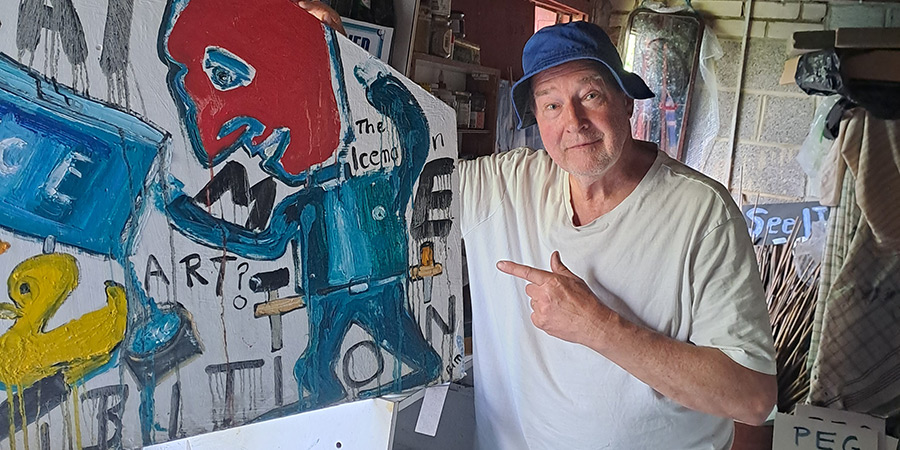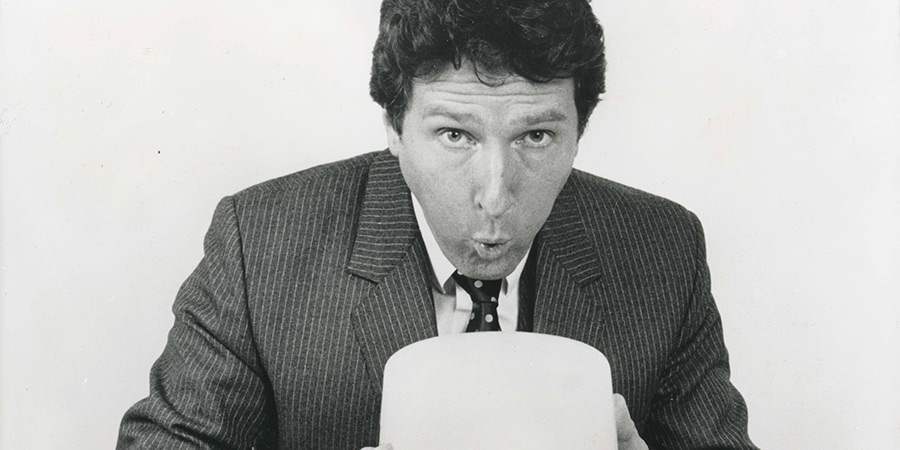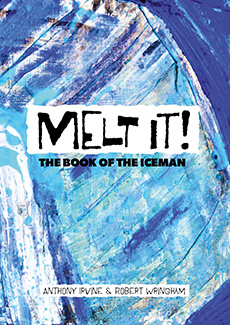Cool as ice - a chat with The Iceman

Anthony Irvine, AKA The Iceman, is something of a legend on the alternative comedy circuit; his ice melting act is fondly remembered by comedians like Stewart Lee and Jo Brand. As his book Melt It! is published by GoFasterStripe and he launches an exhibition of his artwork, we chat to Anthony about his act, the triumphant nature of failure and his progression into painting...
What made you want to melt blocks of ice?
I'd always been interested in performance art, back when we called it 'performance art', because it seemed to be breaking a few boundaries. It was also a very personal thing. It sounds pretentious, but I think I was conveying my own desperation in public, so I think it had a therapeutic element in the beginning. Then it turned more into art.
I'll always remember the first ones [live shows] because they were very pure. I'd just arrive with the ice and various pieces of equipment. I never planned what would happen other than ice would figure.
It's very symbolic. Time, mortality, it encapsulates the universe.
We're you a fan of the comedy scene at the time?
Not so much a fan, but it was a ready-made context to do my stuff. From the word go, I think comedians - although it was a bit more varied then - found me a bit too off beam.
Very early on, I went to the original Comedy Store in Soho. Very ambitious people there like Rik Mayall, Ben Elton, Keith Allen, Alexei Sayle, all those people. I think they just saw me as a rather odd phenomenon. I did do a bit of verbal comedy in those days. I did another act called Crane, which Malcolm Hardee refers to in his autobiography, where I took a big chain and picked up a bag of tooth equipment, cleaned my teeth and talked aloud.

There was much more variety on the circuit back then.
Yes, I remember Keith Allen breaking plates on his head. I was on the night he said "I'm going to become an actor and sacrifice cabaret".
Did you see yourself as a comedian, a performance artist or a mishmash of the two?
A mishmash at the beginning. I quickly realised that I wasn't a comedian, in the normal sense of the word. It was more art based. As I say in the book, Melt It!, people used to say 'you should be in art galleries' and the gallery people would say 'you should be in comedy'! There was always an element of wanting to entertain, but the main focus was the block.
Would you have a different act for when you went in front of a comedy club audience?
I had the same act, if you can call it an act. I always used to say 'I'm doing this for real', which Simon Munnery picked up on when he wrote the foreword to my book.
I realised I couldn't just play around with feelings for twenty minutes, that's when I used to compromise, in my own terms, and tried to create a structure. It would build. I'd start by using breath and quite passive things and ended up with explosions and things, so it would build. Within that, I used to tell really bad jokes. I think people laughed out of desperation. Then there were the puns - "I Icecaped from an Icesylum" - and I'd have a rubber duck I'd put in the bucket.
Stewart Lee says in the afterword in the book that he didn't like the puns so much, but that was the beginning of trying to be a bit funnier. I suppose I wouldn't have gotten as many bookings if it was purely visual.
You played Malcolm Hardee's Tunnel Club, known for its notoriously tough audiences. How did the act go over with them?
There's a story in the book, my ice melted in the Blackwall Tunnel but I didn't realise. So I went onstage and turned my bucket over and all this water gushed out. I said something like "Oh, I can go home now". They laughed and I did, so I survived that one. But when the ice didn't melt, it was quite rough, like going into a bear pit. If I was in real danger, Malcolm would come on and have a piss.
But although they were rough, they couldn't work me out, so while they were aggressive, they found me unpredictable. I'm not saying I was frightening, but I had a lot of ornaments and explosions. I had so much equipment, they felt if they tried anything then I might have had the wherewithal to come back at them in a heavy way.
The explosions were quite big. I came on with a big belt full of hammers and chisels, so it looked like I could look after myself.
You mentioned explosions. Did your act ever lead to injury, either for you or the audience?
I used to set off fire alarms quite frequently. I think I was in more danger than I realised. There was always electricity with the microphone, flammable de-icer spray and blowtorches, so I'm lucky really that I didn't hurt either myself or other people.
The health and safety regulations weren't as strong in those days. On the whole I was reasonably careful. I deafened an audience once, I had an explosion sound effect which I put in a bin, which I thought would be safer, but the result was the most deafening sound ever created since the Big Bang!
Comedians including Stewart Lee, Simon Munnery, Jo Brand, Bill Bailey and even Mike Myers have cited you as a brilliant act. What does it feel like to get those kinds of compliments from your peers?
It's quite reassuring in a way, because I wasn't successful, in the normal sense of the word, but to know people appreciated what I was trying to do is quite gratifying. I wasn't aware of it at the time, but looking back it's rather nice. Perhaps they should have done more with me!
It could be said that your act is almost a study in failure in a way, though, of course, ice is always going to melt so it can really never fail.
Yes, I never went on with the expectation of getting laughs or going well. I knew I'd be a catalyst for this block, in a way it removed performance anxiety and nerves. I delighted in the desperation, people felt sympathy because I think sometimes they really were concerned for my welfare, they didn't know if I was acting or really desperate.
But, you're right, the ice melting anyway is the final art, success comes eventually. I once had a huge can of water and, at the end, I hid the ice - which was a bit of a cheat - and poured the water to make the duck float. The duck used to be the gage of how well the act had gone.

What are your memories of some of the other acts on the circuit at the time?
He's not particularly well known, but I used to be amused by a guy called Tony Green, who played a character called Sir Gideon Vein, this ridiculous, over the top thespian. He ran a club called Open Heart in East London. A lot of performance artists, like Ian Hinchcliffe, used to come. He was so unpredictable and broke every rule.
I remember playing a club in Clapham with Jo Brand and there was only one person in the audience, but we still did the show.
I formed a little theatre group with Andrew Bailey, very quirky, and a guy called Simon, who had a funeral hearse. We used to go to festivals together. Andrew was reasonably small, I was in the middle then there was Simon, it was visually very good. People used to come up to us in garages and offer their condolences. Then the hearse turned into a sort of theatre platform. We had quite a weird show together!
There were quite a few quirky acts around at the time, like Chris Lynam -
Ah yes, the firework up the bum. He was very dynamic. He actually booked me and a group of us to play the Rolling Stones concert at Knebworth. I didn't quite make it onstage, for various reasons. I think they wanted to create a carnival type of atmosphere, so they booked a load of clown-y type people. Unfortunately I missed my moment.
Did you at least get to meet The Stones?
No!
You also played Glastonbury, did that go any better?
Some hippies took the block. I was meant to be in the cabaret tent. Everybody was there, Chris Lynam, Malcolm Hardee, but I was privileged because I was the only one allowed electricity, to power the generator for my freezer with the block. It was whirring all night, people thought I was a real VIP. 1990 it was, The Iceman played Glastonbury!
What prompted the move away from performing?
I had to earn a proper living, and ice melting didn't quite earn enough. I did quite a lot of different jobs. I started painting, oil paintings. That's my main activity. Completely different experience, because it's solitary and quite reflective. A lot of it is based on memories. Come to my first and last exhibition - at the Guggleton Farm in Dorset [until 5th August 2023].
The ice blocks live on, intertwined with the painting. I now try and sell my paintings interactively, so it's a new kind of performance. One in a hundred meetings I get a sale!
Can you see yourself performing again, either in a comedy club or elsewhere?
The ice act was a huge logistical challenge and I don't think I have the physical strength to get the ice there, perform and get out. I once did a purely verbal comedy show, at the Forest Arts Centre in New Milton. I felt completely naked without my ice. I did a whole thing about therapy and mental issues. It turned out there was an actual therapist in the audience and we interacted a lot. It went well, but it didn't fill me with a desire to do more purely verbal comedy.
In Chaplin's in Bournemouth recently I did an interview and took a block. I don't think I'm going to do that again, but I do like the painting, which reminds one of performance. They're the same motif, The Iceman and his block. Of my one thousand odd paintings, they're basically all autobiographical.
One of your last high profile performances was when Stewart Lee invited you to take part in At Last, The 1981 Show! in 2011. What was that experience like?
I was actually in the foyer. It's a huge foyer, I was there and on the main stage Stewart told the audience to come out and see me, so suddenly I got inundated with all his fans. It was a funny evening which oscillated between being small and huge. I've got a photo somewhere of people queuing up to get a copy - I did fax copies of the block - and I'd sign them. They could be quite valuable!
I also removed myself from the ice and mixed with the audience, so people weren't quite sure who I was or what I was. I didn't take possession of the ice like I normally would, and afterwards it ended up in the River Thames.
Probably the cleanest water to touch the Thames for quite some time! You appeared briefly in the brilliant 1995 film Funny Bones. How did that come about?
We filmed at Ealing Studios. I filmed for three days. I think they thought it was going to be a skill act whereas actually it was a concept act, so in one way it wasn't really appropriate for that music hall type of thing. I thought it would be huge for me personally, I went to the premiere but didn't see myself, except for my credit. There's a microsecond where you can see me and the block on the stairs for the audition scene. But I thought that was quite appropriate. It reminded me that I'm not really in any of those fields, I just melt blocks of ice.
What was it like putting your book Melt It! together?
I'd always had this idea to put something together. Robert Wringham had done books with GoFasterStripe, he got in touch and wanted to know how many polaroids I had - I used to photograph each block - and he was a bit disappointed because I only have fifty six left, but in a way that makes them more special. So we centred the book around those fifty six blocks and did an interview, I got some of my paintings in. Simon Munnery did the foreword and Stewart Lee wrote an afterword. I liked the contrast, because Simon was very concise, focussing on one specific memory of a gig, whereas Stewart was quite poetic.
It's nice, because I focus much more on my art now. Actually, I sold a painting to Mark Thomas the other day. I have an exhibition at the Guggleton Farm from the 7th July to the 5th August. I'm billing it as a clearance sale, and I'm trying out a raffle system whereby people can predict how many pieces I'll sell and whoever has the nearest guess wins a painting.
Help us publish more great content by becoming a BCG Supporter. You'll be backing our mission to champion, celebrate and promote British comedy in all its forms: past, present and future.
We understand times are tough, but if you believe in the power of laughter we'd be honoured to have you join us. Advertising doesn't cover our costs, so every single donation matters and is put to good use. Thank you.
Love comedy? Find out moreMelt It! The Book Of The Iceman

The Iceman has an unusual comedy act. He melts large blocks of ice. He does this while punning his way through ice-based monologues. A plastic duck lingers in a trough beneath an overflow pipe, interminably waiting to be lifted by meltwater.
Alone with his props and a persistent vision, The Iceman (real name Anthony Irvine) played the most important venues in alternative comedy through the 1980s and 90s. He appeared on television, in a feature film, and on the radio, all with the singular mission of melting ice that, as some have pointed out, would have melted anyway.
56 numbered Polaroids - all that remains of the Iceman's blocks - are presented here in thrilling instamatic colour, an attempt at unlikely immortality.
Find out what the Iceman was thinking. Hear where he came from and what happened when he vanished. What are 'ghost blocks' and who is 'the Blockless One'? These questions and more are finally answered in this unique pictorial interview with the legend that is The Iceman!
First published: Thursday 19th January 2023
- Publisher: Go Faster Stripe
- Pages: 184
- Catalogue: 9781838457150
![]() Buy and sell old and new items
Buy and sell old and new items
Search for this product on eBay
BCG may earn commission on sales generated through the links above.
- Publisher: Go Faster Stripe
BCG may earn commission on sales generated through the links above.


